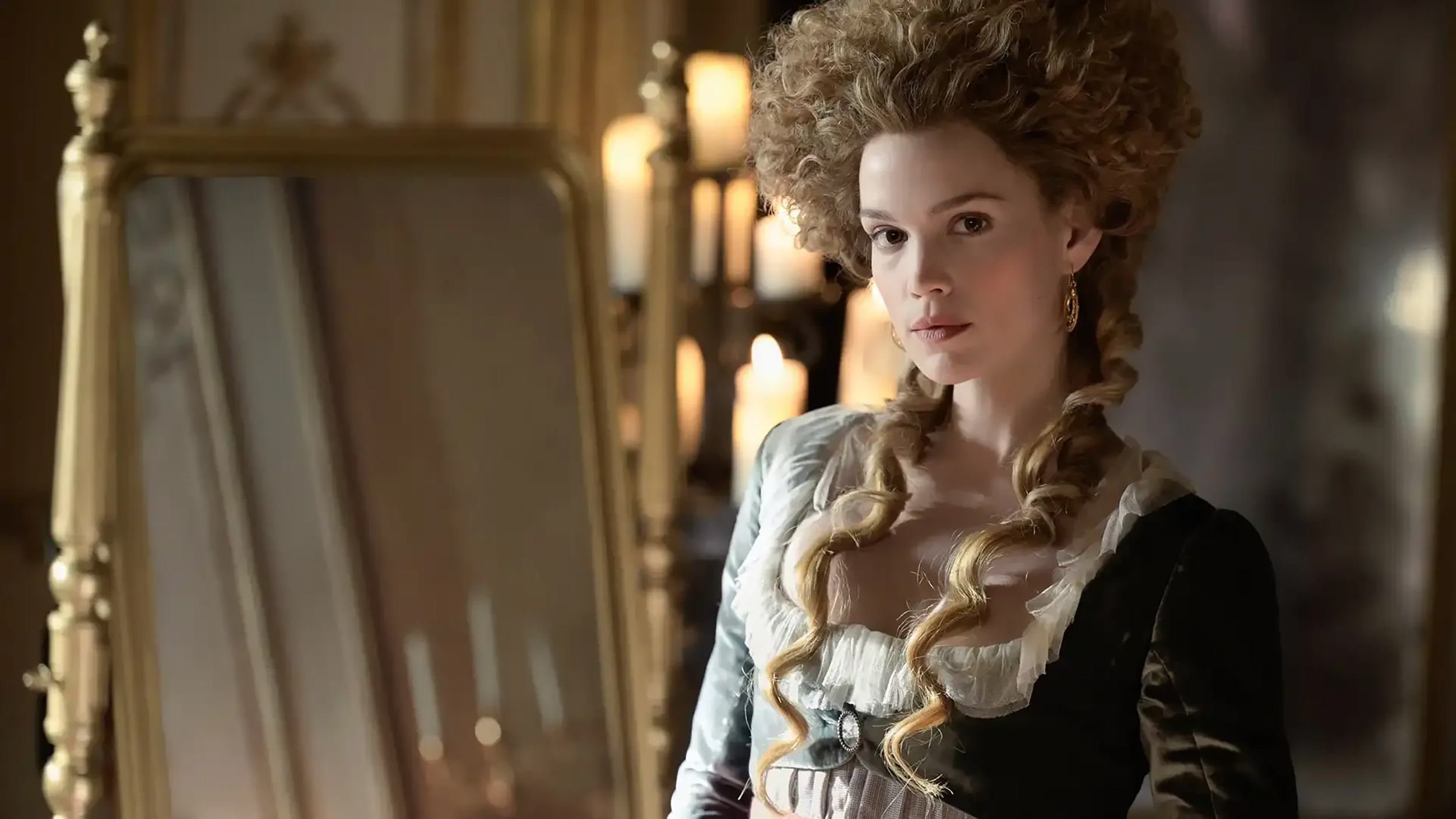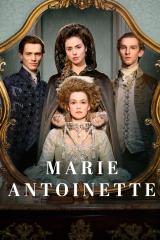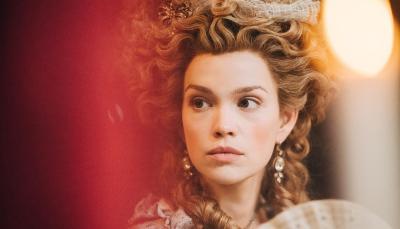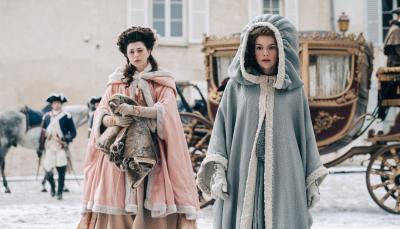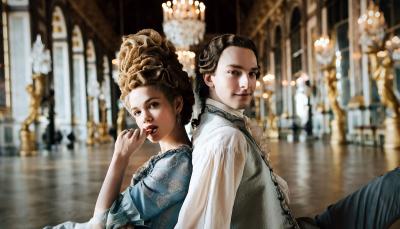All In The Details: Making 'Marie Antoinette' Season 2 Costumes Dazzle
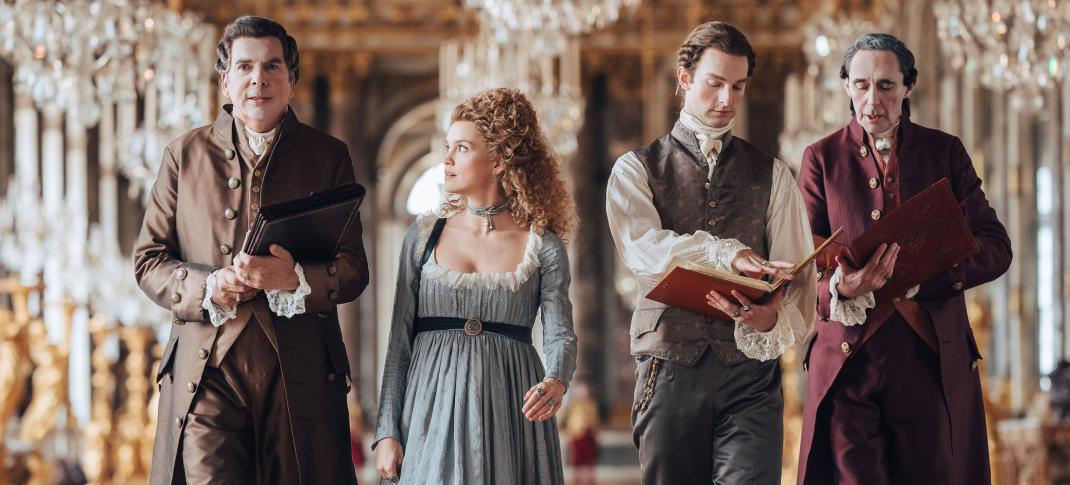
Patrick Albenque as Breteuil, Emilia Schüle as Marie Antoinette, Louis Cunningham as Louis XVI, and Guy Henry as Vergennes in 'Marie Antoinette' Season 2
Caroline Dubois / Capa Drama / Canal Plus
From the start, the second season of Marie Antoinette holds a smattering of small victories and an overabundance of significant-to-catastrophic losses, but everyone sure looks gorgeous through it all. We could publish daily close-reads of nearly every scene’s visual riches, and if there were considerably less TV to cover, we might! In the absence of unlimited time and word counts, however, we’re delighted to share insights from series costume designer Marie Fremont’s generous behind-the-scenes look at her team’s approach.
The scope and scale of work required to keep the Court of Versailles in late 18th-century splendor through the second season’s many ups and downs — A frigid winter! Illicit affairs! A pregnancy of questionable parentage! Increasing political unrest! The French economy teetering on a knife edge! A jewel scam to make Ocean’s 8 look like child’s play! — is astonishing. Fremont noted immediately that “even if we were able to reuse a few costumes from the end of Season 1, every piece for the 30 first main characters are made bespoke in our workshop,” going well beyond the dresses, coats, and breeches to encompass “corsets, chemises, and petticoats, [and everything from] coats to shirts for the men.”
The vast number of items to be created required “a fantastic team of about 60 people”, and even all of their work was supplemented with costume rentals from houses across Europe for extras and background actors to wear. Considering the vast number of garments and various fabrics, some pieces had to be worn too frequently to be laundered on a routine schedule. On such occasions, these items got the classic costumer’s treatment of “vodka, generously sprayed on each piece at the end of the day” to kill bacteria, deodorize, and make them suitable for wear again the following day.
Although photography wouldn’t be invented for many decades past Marie Antoinette’s lifetime, far more research materials exist beyond formal portraits such as those painted by Élisabeth Vigée le Brun or descriptions in surviving letters and financial records of the period. In addition to inventories by ladies-in-waiting, Fremont described the gazette des atours as “a notebook filled with small samples of each of Marie Antoinette’s dresses,” where she “indicated with pins the dresses she wanted to wear during the day.” Remarkably, “the tiny pinholes” left behind are still visible today.
While the Vigée Le Brun paintings are the team’s first sources for details, Fremont notes that in their reconstructions of the queen’s gowns, “we’ve generally lightened the ornamentation a little, which to our modern eye would have seemed a little overloaded.” The designer’s comment is particularly apt when thinking about the necklace at the heart of one of the worst scandals threatening to engulf Marie Antoinette this season, The Affair of the Diamond Necklace.
Insisting on exacting historical accuracy can be distracting and break the spell of believability a series or film needs to maintain over contemporary viewers. Sometimes, this means exercising visual restraint, and other times, one has to go bigger to be believable.
This appears to be the case with the on-screen presentation of the controversial necklace, which is generally believed to be The Sutherland Necklace, on display at the Victoria & Albert Museum in London. The single strand of astonishingly clear and brilliant stones – most weighing in at 15-20 carats – is remarkable on its own but bears little resemblance to the swoopy, festoon-laden necklace shown in Marie Antoinette. It’s a small but not-insignificant detail, an inside baseball element for the “if you know, you know” crowd.
Re-creating aspects of the Vigée Le Brun portraits also gave Fremont one of her favorite costuming moments of the season. The marked contrast between the first season’s massive gowns and the second season’s en gaulle dresses, which are “so light and modern, and [feature] all these short jackets on top,” offered variety for the designers, makers, and actors. The en gaulle frocks (also called chemise à la reine) were controversial in their day for being so casual that some viewers thought they looked slutty, and for the lack of patriotism, they reflected.
The sudden popularity of the dresses’ cotton muslin unintentionally undermined the French silk industry at a time when the national economy as a whole was precarious, at best. A third problem with the style is the role it played in the profitability of the transatlantic slave trade. All three issues are discussed in more detail in a 2018 Racked piece.
A less political but no less illuminating costuming detail from the second season pertains to a silk dressing gown Fremont created for the scheming Duc d’Orléans. The decor inspired the allover print of fans in various shades in “an 18th-century private residence just outside Paris” that stood in for the duke’s real-world apartment. The “magnificent Chinese lacquers of the time” caught Fremont’s eye, leading to the creation of a robe that would look as chic in a contemporary fellow’s wardrobe as it does in the series. Equally, many of the men’s embroidered coats that appear across the season “appealed to our actresses, who easily imagined them worn on the red carpet,” proving once more that garments of the past can look fresh and modern when we have eyes to see.
Marie Antoinette Season 2 airs Sundays on most local PBS stations, the PBS App, and the PBS Masterpiece Prime Video Channel at 10 p.m. ET. All eight episodes of the new series are available on PBS Passport for members to stream. Season 1 is available to stream for members on PBS Passport and on the Prime Video Masterpiece Channel.


